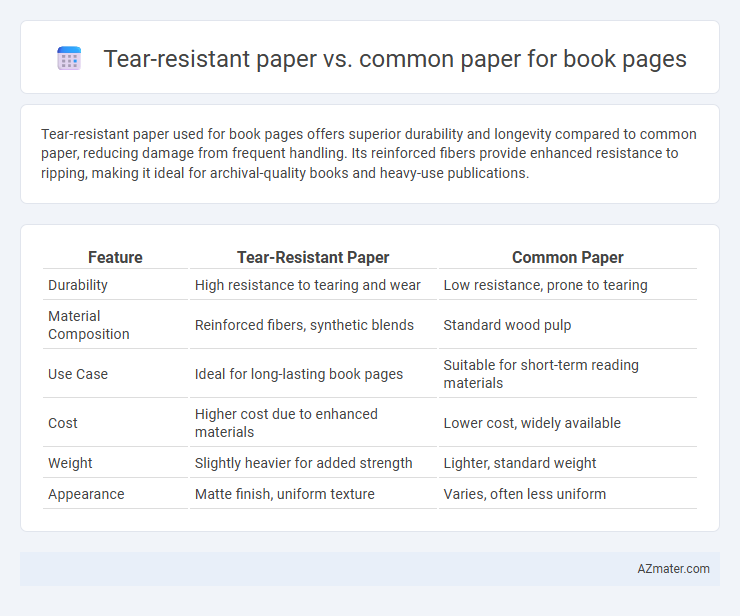Tear-resistant paper used for book pages offers superior durability and longevity compared to common paper, reducing damage from frequent handling. Its reinforced fibers provide enhanced resistance to ripping, making it ideal for archival-quality books and heavy-use publications.
Table of Comparison
| Feature | Tear-Resistant Paper | Common Paper |
|---|---|---|
| Durability | High resistance to tearing and wear | Low resistance, prone to tearing |
| Material Composition | Reinforced fibers, synthetic blends | Standard wood pulp |
| Use Case | Ideal for long-lasting book pages | Suitable for short-term reading materials |
| Cost | Higher cost due to enhanced materials | Lower cost, widely available |
| Weight | Slightly heavier for added strength | Lighter, standard weight |
| Appearance | Matte finish, uniform texture | Varies, often less uniform |
Introduction to Tear-Resistant and Common Paper
Tear-resistant paper is engineered with fibers and binding agents that enhance durability, making it ideal for frequent handling and long-lasting use in book pages. Common paper, typically made from wood pulp without reinforcement, offers standard strength but is more prone to tearing and wear over time. The material composition and manufacturing processes differentiate tear-resistant paper by providing superior resistance to physical damage compared to regular book paper.
Composition and Manufacturing Differences
Tear-resistant paper for book pages is typically composed of synthetic fibers such as polyester or reinforced cellulose, which enhance durability and resistance to tearing compared to common paper made primarily from wood pulp. Manufacturing of tear-resistant paper involves specialized processes like resin impregnation or lamination, increasing fiber bonding strength and providing enhanced flexibility without compromising print quality. Common paper relies on standard wood pulp bleaching and pressing techniques, resulting in a lower tensile strength and higher susceptibility to wear and tear during handling.
Durability and Longevity in Book Pages
Tear-resistant paper significantly enhances the durability and longevity of book pages compared to common paper, offering superior resistance to ripping and wear from frequent handling. Its reinforced fibers and higher quality additives reduce susceptibility to damage caused by bending, folding, and environmental factors, thereby preserving the integrity of printed content over time. Common paper, typically composed of lower-grade cellulose, tends to degrade faster, resulting in brittleness and increased vulnerability to tears, which compromises the lifespan of books.
Tear Resistance: Performance Comparison
Tear-resistant paper exhibits significantly higher durability compared to common paper, with resistance metrics often surpassing standard tensile strength by 30-50%. Its enhanced fiber bonding and coating technologies minimize the risk of ripping under stress, making it ideal for high-handling book pages. Common paper typically tears easily due to weaker fiber composition and lack of reinforcement, resulting in lower longevity and increased susceptibility to damage.
Texture and Feel: Reader Experience
Tear-resistant paper for book pages offers a smoother, more durable texture that enhances the tactile experience without compromising flexibility, unlike common paper which often feels rougher and more fragile. Readers notice the sturdier, high-quality feel of tear-resistant paper, leading to increased comfort and confidence in handling the book over time. This improved texture and durability contribute to a more satisfying, long-lasting reading experience.
Print Quality and Ink Absorption
Tear-resistant paper offers superior print quality due to its smooth, coated surface that enhances ink adhesion and prevents smudging compared to common paper. Its optimized ink absorption reduces bleed-through and ensures sharper, more vibrant text and images on each book page. In contrast, common paper often absorbs ink unevenly, resulting in weaker print clarity and potential ink feathering.
Cost Analysis: Tear-Resistant vs Common Paper
Tear-resistant paper typically costs 20-30% more than common paper due to enhanced durability features such as reinforced fibers and specialty coatings, which increase manufacturing expenses. Despite the higher upfront cost, tear-resistant paper reduces long-term replacement and repair expenses, making it cost-effective for high-use books or archival materials. Common paper, while cheaper initially, may incur higher cumulative costs from frequent damage and replacement, especially in environments requiring frequent handling.
Eco-Friendliness and Recycling Considerations
Tear-resistant paper uses synthetic fibers or coatings that enhance durability but may complicate recycling processes compared to common paper, which is typically made from natural cellulose fibers and is easier to recycle. Common paper generally has a lower environmental footprint as it decomposes faster and requires less energy during recycling, while tear-resistant paper's additives can introduce contaminants or require specialized recycling facilities. Choosing eco-friendly tear-resistant options with biodegradable additives can help balance durability and environmental impact in book production.
Ideal Book Types for Each Paper Option
Tear-resistant paper is ideal for children's books, textbooks, and manuals where durability and frequent handling are crucial, preventing damage from rough use and extending the book's lifespan. Common paper suits novels, poetry collections, and general reading materials where cost-effectiveness and smooth printing are prioritized over heavy-duty resilience. Selecting tear-resistant paper enhances longevity in high-traffic books, while common paper balances quality and budget for standard literary works.
Conclusion: Choosing the Right Paper for Books
Tear-resistant paper offers superior durability and longevity compared to common paper, making it an ideal choice for books that require frequent handling or long-term preservation. Common paper is often more cost-effective but may deteriorate quickly under heavy use or environmental stress. Selecting the right paper depends on balancing budget constraints with the intended lifespan and usage conditions of the book.

Infographic: Tear-resistant paper vs Common paper for Book page
 azmater.com
azmater.com